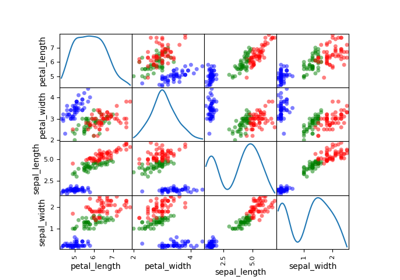gaussian_mixture module¶
The Gaussian mixture algorithm for clustering.
The Gaussian mixture algorithm groups the data into clusters. The number of clusters is fixed. Each cluster \(i=1, \cdots, k\) is defined by a mean \(\mu_i\) and a covariance matrix \(\Sigma_i\).
The prediction of the cluster value of a point is simply the cluster where the probability density of the Gaussian distribution defined by the given mean and covariance matrix is the highest:
where \(\mathcal{N}(x; \mu_i, \Sigma_i)\) is the value of the probability density function of a Gaussian random variable \(X \sim \mathcal{N}(\mu_i, \Sigma_i)\) at the point \(x\) and \(\|x-\mu_i\|_{\Sigma_i^{-1}} = \sqrt{(x-\mu_i)^T \Sigma_i^{-1} (x-\mu_i)}\) is the Mahalanobis distance between \(x\) and \(\mu_i\) weighted by \(\Sigma_i\). Likewise, the probability of belonging to a cluster \(i=1, \cdots, k\) may be determined through
where \(C_i = \{x\, | \, \operatorname{cluster}(x) = i \}\).
When fitting the algorithm, the cluster centers \(\mu_i\) and the covariance matrices \(\Sigma_i\) are computed using the expectation-maximization algorithm.
This concept is implemented through the GaussianMixture class
which inherits from the MLClusteringAlgo class.
Dependence¶
This clustering algorithm relies on the GaussianMixture class of the scikit-learn library.
- class gemseo.mlearning.clustering.gaussian_mixture.GaussianMixture(data, transformer=mappingproxy({}), var_names=None, n_components=5, **parameters)[source]
Bases:
MLPredictiveClusteringAlgoThe Gaussian mixture clustering algorithm.
- Parameters:
data (Dataset) – The learning dataset.
transformer (TransformerType) –
The strategies to transform the variables. The values are instances of
Transformerwhile the keys are the names of either the variables or the groups of variables, e.g."inputs"or"outputs"in the case of the regression algorithms. If a group is specified, theTransformerwill be applied to all the variables of this group. IfIDENTITY, do not transform the variables.By default it is set to {}.
var_names (Iterable[str] | None) – The names of the variables. If
None, consider all variables mentioned in the learning dataset.n_components (int) –
The number of components of the Gaussian mixture.
By default it is set to 5.
**parameters (int | float | str | bool | None) – The parameters of the machine learning algorithm.
- Raises:
ValueError – When both the variable and the group it belongs to have a transformer.
- LIBRARY: Final[str] = 'scikit-learn'
The name of the library of the wrapped machine learning algorithm.
- SHORT_ALGO_NAME: ClassVar[str] = 'GMM'
The short name of the machine learning algorithm, often an acronym.
Typically used for composite names, e.g.
f"{algo.SHORT_ALGO_NAME}_{dataset.name}"orf"{algo.SHORT_ALGO_NAME}_{discipline.name}".
- algo: Any
The interfaced machine learning algorithm.
- learning_set: IODataset
The learning dataset.
- n_clusters: int
The number of clusters.
- transformer: dict[str, Transformer]
The strategies to transform the variables, if any.
The values are instances of
Transformerwhile the keys are the names of either the variables or the groups of variables, e.g. “inputs” or “outputs” in the case of the regression algorithms. If a group is specified, theTransformerwill be applied to all the variables of this group.

